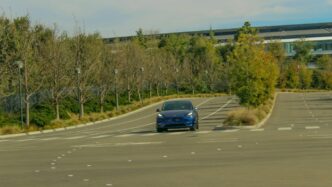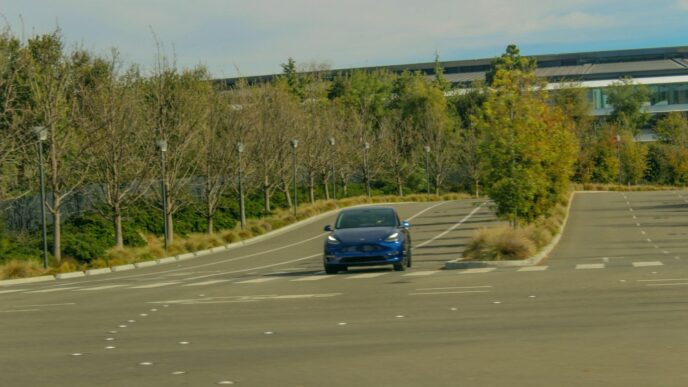Self-driving cars, once a concept of science fiction, are rapidly becoming a reality. As technology advances, these vehicles promise to change how we travel, making it safer and more efficient. However, along with the excitement come challenges that need to be addressed. This article explores the evolution, technology, and impact of autonomous vehicles on society and the economy.
Key Takeaways
- Self-driving cars use advanced sensors and AI to navigate roads, aiming to reduce accidents caused by human error.
- The shift towards autonomous vehicles could transform transportation, affecting everything from urban design to daily commuting.
- New technologies are reshaping the automotive industry, leading to new business models and competition from tech companies.
- Legal and safety issues must be resolved before self-driving cars can be widely adopted.
- Public acceptance and trust are essential for the future success of autonomous vehicles.
The Evolution of Self-Driving Cars
Early Concepts and Prototypes
Self-driving cars have fascinated people for centuries. The idea dates back to Leonardo da Vinci, who sketched plans for a self-driving cart in the late 1400s. Fast forward to the 1930s, when mechanical autopilots for airplanes began to emerge. The concept gained more attention at the New York World’s Fair, where General Motors showcased a vision of the future with self-driving cars.
Technological Breakthroughs
Recent advancements in technology have made self-driving cars a reality. Key developments include:
- GPS and digital mapping
- Powerful computing systems
- Advanced sensor technologies
These innovations allow cars to navigate and understand their surroundings better than human drivers.
Current State of Autonomous Vehicles
Today, self-driving cars are at various levels of autonomy. The table below outlines these levels:
| Level | Description |
|---|---|
| Level 1 | Human driver does all the driving. |
| Level 2 | Vehicle assists with steering or braking, but not both. |
| Level 3 | Vehicle can control both steering and braking under certain conditions, but human must monitor. |
| Level 4 | Vehicle can perform all driving tasks in specific situations without human attention. |
| Level 5 | Fully autonomous; human occupants are just passengers. |
The journey from early concepts to today’s technology shows how far we’ve come in making self-driving cars a part of our future.
Key Technologies Behind Self-Driving Cars
Sensors and Cameras
Self-driving cars rely heavily on sensors and cameras to navigate their environment. These devices help the vehicle detect obstacles, read traffic signs, and identify pedestrians. Here are some key components:
- Cameras: Capture real-time images of the surroundings.
- Ultrasonic Sensors: Measure distance to nearby objects.
- Radar: Detects the speed and distance of other vehicles.
Artificial Intelligence and Machine Learning
At the heart of self-driving technology is artificial intelligence (AI). AI systems analyze data from sensors to make driving decisions. Key aspects include:
- Data Processing: AI processes vast amounts of data quickly.
- Learning from Experience: Machine learning allows the car to improve over time.
- Decision Making: AI helps the vehicle decide when to stop, go, or change lanes.
LIDAR and Radar Systems
LIDAR (Light Detection and Ranging) is crucial for creating a 3D map of the environment. It works by sending out laser beams and measuring how long it takes for them to return. This technology, along with radar systems, enhances the car’s ability to understand its surroundings. Here’s a quick comparison:
| Technology | Functionality | Advantages |
|---|---|---|
| LIDAR | 3D mapping | High accuracy |
| Radar | Distance measurement | Works in poor weather |
In summary, the combination of these technologies is essential for the safe operation of self-driving cars. They work together to create a comprehensive understanding of the vehicle’s environment, significantly reducing the risk of accidents caused by human error. The transformative role of automotive telematics in this field cannot be overstated, as it shapes the future of transportation.
Safety and Security Concerns
Reducing Human Error
Self-driving cars aim to reduce human error, which is a major cause of accidents. By using advanced sensors and AI, these vehicles can react faster than humans. This technology could potentially save thousands of lives each year. Here are some key points:
- Autonomous vehicles can detect obstacles and hazards more quickly.
- They can maintain safe distances from other vehicles.
- They follow traffic rules consistently, unlike human drivers.
Cybersecurity Threats
As cars become more connected, cybersecurity threats increase. Hackers could potentially take control of a vehicle, leading to dangerous situations. To combat this, manufacturers must:
- Implement strong encryption methods.
- Regularly update software to fix vulnerabilities.
- Educate users about safe practices.
Public Perception and Trust
Public acceptance is crucial for the success of self-driving cars. Many people are still skeptical about their safety. A recent survey showed that 68% of individuals are afraid of partially-automated vehicle technology. To build trust, companies need to:
- Provide transparent information about safety measures.
- Share data on accident rates compared to human drivers.
- Engage with communities to address concerns.
The journey to fully autonomous vehicles is filled with challenges, but addressing safety and security concerns is essential for gaining public trust and ensuring a smooth transition to this new era of transportation.
In summary, while self-driving cars promise to enhance safety by reducing human error, they also face significant challenges related to cybersecurity and public perception. Addressing these issues is vital for their widespread adoption.
Impact on the Automotive Industry
Changes in Car Manufacturing
The rise of autonomous vehicles (AVs) is reshaping how cars are made. Manufacturers are now focusing on technology rather than just traditional mechanics. This shift means:
- Increased collaboration with tech companies.
- A focus on software development and AI integration.
- New designs that prioritize passenger comfort and safety.
New Business Models
As AVs become more common, the way companies make money is changing. Instead of just selling cars, automakers are exploring:
- Ride-hailing services like Uber but with self-driving cars.
- Car-sharing platforms where people can rent AVs as needed.
- Subscription models that allow users to pay for access to a fleet of vehicles.
Competition from Tech Giants
The automotive industry is seeing new players enter the market. Companies like Google and Tesla are investing heavily in AV technology, creating a competitive landscape. This means:
- Traditional automakers must innovate quickly to keep up.
- There’s a greater focus on safety and reliability in AVs.
- New partnerships between car makers and tech firms are becoming essential.
The automotive industry is at a crossroads, where technology and innovation are key to survival and growth.
Interior Design Innovations
With AVs, the inside of cars can be redesigned since passengers won’t need to focus on driving. This opens up possibilities for:
- More comfortable seating arrangements.
- Features for entertainment or productivity.
- Advanced sensor placements for safety and efficiency.
Summary
The impact of autonomous vehicles on the automotive industry is profound. From new business models to innovative designs, the future of transportation is being redefined. As the industry adapts, it will be crucial for traditional automakers to embrace these changes to remain relevant in a rapidly evolving market.
Legal and Regulatory Challenges
Current Laws and Regulations
The rise of self-driving cars brings a need for new laws and regulations. Governments must create rules that cover:
- Safety standards for autonomous vehicles.
- Data privacy to protect user information.
- Liability in case of accidents involving self-driving cars.
Liability and Insurance Issues
Determining who is responsible in an accident with a self-driving car is complex. Key points include:
- Manufacturer liability: If a car malfunctions, is the maker responsible?
- Driver responsibility: What if the human driver was at fault?
- Insurance adjustments: How will insurance companies adapt to fewer accidents?
Future Legal Frameworks
As technology evolves, so must the laws. Future frameworks should:
- Encourage innovation while ensuring safety.
- Address cybersecurity threats to protect vehicles from hacking.
- Promote public trust in autonomous technology.
The legal landscape for self-driving cars is still developing, and clear regulations will be essential for their success.
| Aspect | Current Status | Future Needs |
|---|---|---|
| Safety Standards | Varies by region | Unified global standards |
| Data Privacy | Limited regulations | Comprehensive laws |
| Liability | Unclear | Defined responsibilities |
Economic Implications of Self-Driving Cars
Job Displacement and Creation
The rise of self-driving cars will change the job landscape significantly. While some jobs may disappear, new opportunities will emerge. Here are some potential changes:
- Professional drivers (like truck and taxi drivers) may face job loss.
- New roles in software development and vehicle maintenance will be created.
- Companies will need to invest in retraining programs for affected workers.
Effects on the Global Economy
Self-driving cars could boost the economy in various ways:
- Increased productivity due to less time spent driving.
- Lower transportation costs for businesses and consumers.
- New business models emerging around ride-sharing and vehicle fleets.
| Economic Impact | Description |
|---|---|
| Job Creation | New roles in tech and maintenance |
| Cost Reduction | Lower costs for transportation services |
| Productivity Increase | More efficient travel leading to economic growth |
Changes in Consumer Behavior
As self-driving cars become common, how we think about car ownership may change:
- Many might prefer ride-sharing over owning a car.
- This could lead to a decrease in car sales.
- Consumers may spend their time and money on other activities instead of driving.
The shift to self-driving cars could redefine how we view transportation, making it more accessible and efficient for everyone.
In summary, the economic implications of self-driving cars are vast, affecting jobs, the economy, and consumer habits. As we move forward, understanding these changes will be crucial for adapting to a new transportation landscape.
Environmental Benefits and Challenges
Reduction in Emissions
Self-driving cars can significantly lower emissions by optimizing driving patterns. They can maintain steady speeds and reduce unnecessary acceleration, which leads to better fuel efficiency. This can help in the fight against climate change and improve air quality in urban areas.
Energy Efficiency
Autonomous vehicles are designed to be more energy-efficient. Here are some ways they achieve this:
- Predictive cruising: Adjusting speed based on traffic conditions.
- Route planning: Finding the shortest and least congested paths.
- Smooth acceleration and braking: Reducing energy waste.
Urban Planning and Infrastructure
The rise of self-driving cars may change how cities are designed. For example:
- Fewer parking lots: If people don’t own cars, the need for parking spaces will decrease.
- Less road construction: With better traffic flow, the demand for new roads may decline.
- Improved public transport: Autonomous vehicles can complement public transit systems, making them more efficient.
The shift to autonomous vehicles could reshape our cities, making them cleaner and more efficient.
In summary, while self-driving cars offer many environmental benefits, they also present challenges that need to be addressed to ensure a sustainable future.
Social and Cultural Impacts
Changes in Daily Commutes
The rise of self-driving cars is set to change how we commute. Many people may no longer need to drive themselves, leading to more free time. This could mean:
- Increased productivity during commutes.
- Opportunities for social interactions while traveling.
- A shift in how we view personal transportation.
Accessibility for All
Self-driving cars can make transportation easier for everyone, especially those who cannot drive. This includes:
- Elderly individuals who may have lost their driving abilities.
- People with disabilities who need accessible transport.
- Families who can travel together without worrying about who drives.
Public Acceptance
As self-driving cars become more common, public opinion will play a crucial role. A recent survey showed that 68% of people are afraid of partially-automated vehicles. To build trust, it’s important to:
- Educate the public about safety features.
- Share success stories from early adopters.
- Involve communities in discussions about AV technology.
The shift to autonomous vehicles is not just about technology; it’s about how we live and interact with each other in our daily lives.
Summary Table of Potential Impacts
| Impact Area | Description |
|---|---|
| Daily Commutes | More free time and productivity |
| Accessibility | Easier transport for the elderly and disabled |
| Public Acceptance | Need for education and community involvement |
The Future of Transportation
Integration with Public Transit
The future of transportation will likely see self-driving cars working alongside public transit systems. This integration can lead to:
- Improved efficiency in commuting
- Reduced traffic congestion
- Enhanced accessibility for those who rely on public transport
Innovations in Vehicle Design
As technology advances, vehicle designs will evolve. Key innovations may include:
- Wireless charging systems, like those being adopted by Google, making it easier to keep vehicles powered.
- Sleeker, more aerodynamic shapes to improve energy efficiency.
- Smart interiors that adapt to passenger needs, enhancing comfort and usability.
Predictions and Timelines
Experts predict that within the next 15 to 20 years, we will see significant changes in how we travel. Some expected outcomes include:
- A shift from personal car ownership to shared autonomous vehicles.
- Changes in urban planning to accommodate new transportation methods.
- A potential decrease in the need for parking spaces as self-driving cars drop off passengers and park themselves.
The transition to autonomous vehicles is not just about technology; it’s about reshaping our cities and lifestyles for a more efficient future.
This future holds exciting possibilities, but it also requires careful planning and adaptation to ensure that all communities benefit from these advancements.
Challenges to Widespread Adoption

Technical and Logistical Hurdles
The journey to fully autonomous vehicles is not without its bumps. Key challenges include:
- Integration with existing infrastructure: Current roads and traffic systems need updates to accommodate self-driving cars.
- Sensor reliability: Ensuring sensors work perfectly in all weather conditions is crucial.
- Data management: Handling the vast amounts of data collected by autonomous vehicles poses significant challenges.
Cost and Affordability
The price tag for self-driving technology can be steep. Here are some factors affecting costs:
- Research and development: Significant investment is needed to advance technology.
- Manufacturing expenses: Building autonomous vehicles requires specialized parts and systems.
- Consumer pricing: High costs may deter potential buyers, limiting market growth.
Ethical Considerations
As we move towards self-driving cars, ethical questions arise:
- Decision-making in emergencies: How should a car react in unavoidable accident scenarios?
- Data privacy: Protecting user data is essential to maintain trust.
- Job displacement: The impact on driving jobs raises concerns about employment.
The road to autonomous vehicles is paved with challenges, but overcoming them is essential for a safer and more efficient future.
Summary Table of Challenges
| Challenge | Description |
|---|---|
| Technical Hurdles | Integration with infrastructure, sensor reliability, data management |
| Cost and Affordability | High R&D costs, manufacturing expenses, consumer pricing |
| Ethical Considerations | Emergency decision-making, data privacy, job displacement |
The Role of Government and Policy Makers
Funding and Research Initiatives
Governments play a crucial role in the development of self-driving cars. They can provide funding for research and development, which helps in creating safer and more efficient autonomous vehicles. This funding can come from:
- Federal grants
- State budgets
- Partnerships with private companies
Public-Private Partnerships
Collaboration between the public sector and private companies is essential. These partnerships can lead to:
- Shared resources for testing and development.
- Improved infrastructure to support autonomous vehicles.
- Faster implementation of new technologies.
International Collaboration
As self-driving technology evolves, countries must work together to create consistent regulations. This can help in:
- Harmonizing safety standards.
- Sharing data and best practices.
- Ensuring that autonomous vehicles can operate across borders.
Governments must adapt to the rapid changes in transportation technology to ensure safety and efficiency for all.
In summary, the role of government and policymakers is vital in shaping the future of autonomous vehicles. Their actions can lead to safer roads and a more efficient transportation system.
Conclusion
In conclusion, self-driving cars are set to change how we think about transportation. With their ability to see and react to the world around them, these vehicles promise to make our roads safer. However, there are still many hurdles to overcome before they become a common sight. From ensuring the technology works perfectly to figuring out the rules and responsibilities for drivers and passengers, the journey ahead is complex. Yet, as we move forward, it’s clear that autonomous vehicles could reshape our cities and daily lives in ways we are just beginning to understand. The future of driving is not just about cars; it’s about creating a safer, more efficient world for everyone.
Frequently Asked Questions
What are self-driving cars?
Self-driving cars, also known as autonomous vehicles, are cars that can drive themselves without human help. They use technology like sensors, cameras, and computers to navigate roads.
How do self-driving cars work?
They work by using sensors and cameras to see their surroundings. Computers analyze this information to make decisions, like when to stop or turn.
Are self-driving cars safe?
Many believe self-driving cars can be safer than human drivers because they can reduce accidents caused by mistakes. However, there are still risks to consider.
What are the benefits of self-driving cars?
Benefits include less traffic, fewer accidents, and more freedom for people who can’t drive, like the elderly.
Will self-driving cars replace human drivers?
It’s possible that self-driving cars will take over some driving jobs, but new jobs will also be created in areas like technology and vehicle maintenance.
What are the challenges of self-driving cars?
Some challenges include making sure the technology is safe, creating new laws, and getting people to trust self-driving cars.
How will self-driving cars affect the environment?
They could help reduce pollution by optimizing driving patterns and decreasing traffic congestion, but this depends on how they are used.
When will self-driving cars be widely available?
While some self-driving features are already in cars today, fully autonomous vehicles may take several more years to become common on the roads.













